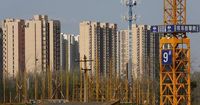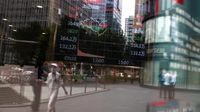China’s real estate market, once a pillar of the world’s second-largest economy, is enduring its most severe crisis in decades, with new data showing home prices continuing to fall despite a barrage of government stimulus measures. The persistent downturn, now stretching into its third year, is rippling through the broader economy, testing the resilience of policymakers and casting a long shadow over global markets.
According to Reuters, new residential property prices in China fell by 0.3% in July 2025 compared to the previous month, matching the decline seen in June. The National Bureau of Statistics confirmed that this was the sharpest monthly drop in nine months, with 60 out of 70 major cities seeing prices slip. While the overall trend remains negative, the pace of decline has slowed in some of the nation’s largest cities, thanks to targeted stimulus measures aimed at property buyers. Still, the data paints a picture of a sector mired in prolonged stagnation, with significant implications for the country’s economic outlook.
Year-on-year, the numbers remain grim. New-home prices in 70 major cities dropped 2.8% in July compared to a year earlier, a modest improvement from the 3.2% annual decline recorded in June, as reported by Mezha. This easing suggests that while the market remains weak, the steepest part of the slide may be behind us—at least in the most sought-after urban centers. Yet, for the majority of cities, especially those outside the first tier, the pain continues. Secondary market sales and resale home values are also on a downward trajectory, with the resale slump narrowing only slightly from 0.61% in June to 0.55% in July, according to Bloomberg.
The roots of this crisis run deep. As highlighted by AInvest, the sector’s woes are the result of oversupply, regulatory crackdowns, and the financial troubles of major developers. The collapse of giants like China Evergrande Group, now delisted from the Hong Kong stock exchange, serves as a cautionary tale of overleveraging. There are currently 400 million square meters of unsold housing across the country—a staggering glut reflecting years of speculative building outpacing genuine demand. Second-tier cities such as Chongqing and Tianjin are seeing annual price declines of 2.9% and 1.8%, respectively. In contrast, Shanghai has bucked the trend with a 6% year-on-year increase in new home prices in June, while Beijing’s decline has slowed from -4.3% in May to -4.1% in June.
“Because households’ heavy reliance on the real estate market, establishing a price bottom is one of the most important factors in restoring confidence and a stable consumer recovery,” noted a market analyst cited by Reuters. The sector, which once accounted for a quarter of China’s GDP, has become a drag on growth. From January to July 2025, real estate investments fell by about 12%, and sales by floor area declined roughly 4% compared to the previous year. The economic impact is not confined to construction and property; it’s feeding through to consumer sentiment, investment, and even global supply chains, particularly those linked to construction materials and engineering firms.
In response, the Chinese government has rolled out an array of stimulus measures. As reported by AInvest, 2025 saw the deployment of a $1.12 trillion package, including interest rate cuts, relaxed mortgage requirements, and a CNY 4 trillion loan program to finish stalled projects. The five-year loan prime rate was reduced by 10 basis points to 3.5%, and the minimum down payment for first-time buyers was capped at 20%. Local authorities have also introduced targeted incentives, such as Beijing’s August 2025 decision to lift some restrictions for qualified homebuyers in the suburbs, while maintaining tighter rules within the city’s Fifth Ring Road.
Despite these efforts, the impact has been uneven. Goldman Sachs estimates that up to 8 trillion yuan in additional spending could be needed to stabilize prices by late 2025. However, Morgan Stanley points out that local banks in provinces like Zhejiang have been slow to implement the new inventory purchase programs. Of the 300 billion yuan relending facility intended for state-owned enterprises to buy up unsold stock, only 4% has been deployed so far. “Urban redevelopment and large-scale purchases of social housing could provide a stable foundation for the sector if policies are implemented effectively,” one economist remarked, reflecting a cautious optimism that hinges on better execution.
The uneven nature of the recovery is a critical factor for investors and policymakers alike. First-tier cities like Shanghai and Beijing, buoyed by robust demand and government support, are showing tentative signs of resilience. These markets are further supported by urban renewal projects and tax incentives. Meanwhile, lower-tier cities such as Guangzhou and Shenzhen are experiencing sharper declines, hampered by high inventories and weaker employment prospects.
Amid the gloom, there are glimmers of opportunity. China’s real estate investment trusts (REITs), launched in 2021, have become a rare bright spot, delivering some of Asia’s highest returns in 2025. Shopping mall REITs, in particular, have outperformed traditional developer stocks. Analysts see potential for the REIT market to grow into a $500 billion asset class by 2030, offering stable yields for investors willing to brave the volatility. Still, these instruments are not immune to the broader sector’s woes; their valuations remain sensitive to ongoing price declines and liquidity constraints.
For those navigating this turbulent landscape, the advice from market experts is clear: focus on resilient markets and cash-flow-strong REITs, avoid overleveraged developers, and keep a close eye on policy execution. Diversifying into construction firms involved in government-led urban renewal and materials suppliers benefiting from stimulus-driven demand may also offer some shelter from the storm. As one strategist put it, “The road ahead is fraught with risks, but history shows that markets recover when fundamentals align with policy.”
The broader economic context only adds to the uncertainty. As Euronews reported, China’s real GDP has stabilized around 5% annually, a far cry from the nearly 7% average seen before the pandemic. The Shanghai Composite Index was trading at the same level as at the end of 2021 by mid-August 2025, after a nearly 30% drop in the interim. In contrast, the S&P 500 has surged 40% in the same period, powered by strong U.S. consumption and technological innovation. Meanwhile, trade tensions with the United States continue to loom large, with the threat of increased tariffs and possible sanctions over China’s imports of Russian crude oil.
In August 2025, Chinese policymakers introduced two interest-subsidy programs to stimulate household consumption and support the services sector. These include a fiscal subsidy of 1 percentage point for consumer loans taken between September 2025 and August 2026, and targeted subsidies for enterprises in eight service industries. Helen Qiao, Bank of America’s chief economist for China, called the initiative significant in scale but questioned its likely impact: “A 1% subsidy on borrowing costs is unlikely to meaningfully influence the purchase decisions of those who need to take out a loan to spend.”
Sentiment remains fragile, with analysts reluctant to call a turning point. “It’s hard to conclude that the sector has exited the crisis,” Qiao observed. “We expect an 8–10% decline in new-home sales and a 15–20% contraction in housing starts this year—similar to the pace in 2023–24.”
For now, China’s real estate market appears stuck between persistent structural challenges and the hope that policy coordination will eventually restore confidence. The stakes are high—not just for China, but for the global economy. The coming months will test whether the government’s latest interventions can finally halt the slide or if the sector’s troubles are destined to linger for years to come.






